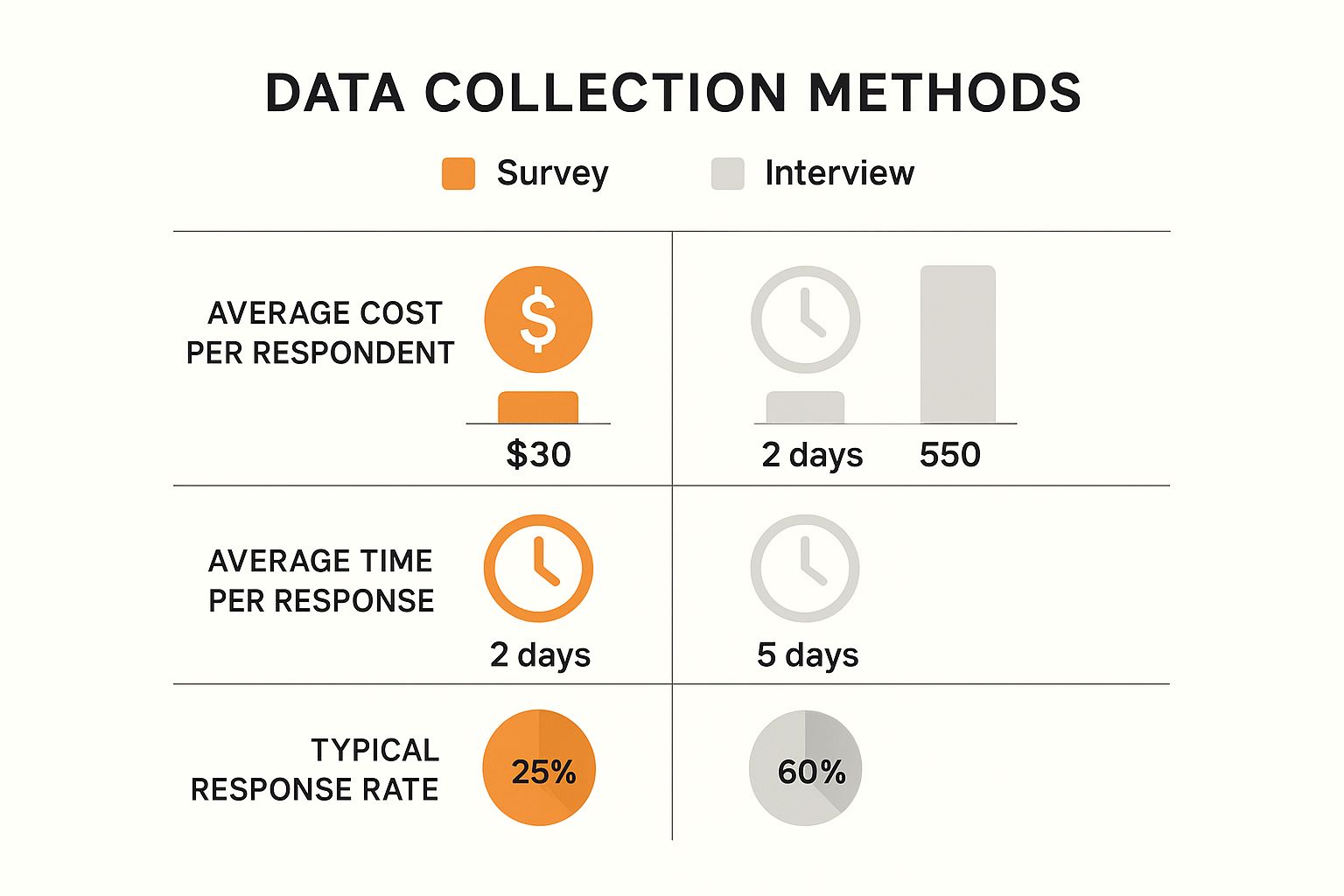So, what exactly is market research? At its core, it's simply the process of gathering and analyzing information about a target market. The goal is to get inside your customers' heads to understand their needs, figure out what problems they're struggling with, and pinpoint what they would actually value in a solution.
Why Most Market Research Fails Founders
Let's be real for a moment—a lot of founders completely miss the mark with market research. I've seen it happen time and again. They'll spend weeks crafting these massive, generic surveys or pour money into off-the-shelf industry reports, only to be left with a pile of data that's too vague to be actionable.
The classic approach often gets bogged down in demographics and market size. While that stuff has its place, it fails to answer the one question that truly matters for a new startup: "What painful problem can I solve?"
This old-school method is a recipe for building products based on guesswork, not genuine, validated demand. For indie hackers and solopreneurs running on tight budgets and even tighter timelines, this kind of mistake can be fatal. You don't need another report telling you the SaaS market is worth billions; you need to know what specific frustration is keeping a potential customer up at night.
Moving Beyond Generic Data
The real trick is to shift your focus from abstract market trends to raw, unfiltered user pain points. Stop asking, "Would you use an app that does X?" Instead, you need to find where people are already screaming, "I wish I had a tool that could solve Y." This problem-first mindset is about listening, not just asking.
The real advantage comes from looking beyond the obvious—diving deeper than your competition is willing to go. It’s about finding the unfiltered attitudes about products like yours, including objections your sales team never hears.
This approach saves you from the classic trap of building in a vacuum. It forces you to ground your efforts in validated problems from the very beginning. We've actually laid out how to structure this entire process in our detailed guide on how to do market research for a startup.
The Founder-Centric Approach
A modern, founder-centric approach to market research is all about authenticity and directness. It means zeroing in on the specific, candid problems people are already discussing in online communities—the places where they feel safe enough to be brutally honest. Your goal isn't just to collect data points; it's to uncover the story behind the problem. What’s the context? How severe is the pain? Who feels it the most?
When you focus on these deep insights, you can:
- Validate ideas faster: Get confirmation that a problem is real and worth solving before you ever write a single line of code.
- Reduce risk: Drastically lower the chances of building something nobody wants or, more importantly, is willing to pay for.
- Build a better product: Your solution will be shaped directly by the real-world needs of your future customers.
This builder-focused mindset completely flips the script. It transforms research from a stuffy, formal task into an ongoing, dynamic conversation with your market.
Let's be honest, traditional market research methods like surveys have a fundamental flaw. They often box people into answering leading questions. You end up with the answers you wanted to hear, not the raw, unfiltered truth.
A much better approach, one I've relied on countless times, is to simply listen where your potential customers are already talking. Online communities, and I'm looking at you, Reddit, are absolute goldmines of organic user pain points.
People in these forums aren't trying to be polite or please a researcher. They're genuinely frustrated and are often screaming into the void, wishing a solution existed. This gives you a direct line to the exact language they use to describe their problems, revealing the true severity of their pain. For any founder, especially an indie hacker or solopreneur, this kind of insight is pure gold.
Tapping into Reddit for Startup Ideas
If you're a founder, Reddit is a treasure trove. You'll find subreddits like r/SaaS, r/indiehackers, and r/solopreneur packed with builders and small business owners openly sharing their daily struggles. The catch? Manually digging through thousands of posts and comments is a brutal, time-consuming slog. It's easy to get lost in the noise.
This is where a specialized tool like ProblemSifter can completely change the game. Instead of spending your weekend scrolling endlessly, it automates the discovery process by identifying real, unfiltered problems on Reddit and pinpointing the exact posts where they appear.
Unlike other tools, ProblemSifter doesn’t just suggest ideas—it connects you to the exact Reddit users asking for them. This is the crucial bridge between just having an idea and actually validating it with real people.
Take a look at how ProblemSifter surfaces problems directly from Reddit discussions.

The most important part of that screenshot isn't just the idea—it's the direct link back to the source. You get the original post and, critically, the usernames of the people who expressed the pain point in the first place.
From Ideation to Targeted Outreach
This method is so much more than just finding an idea; it's about building a direct line to your first customers before you've even written a line of code. Once you've spotted a recurring problem, you suddenly have a ready-made list of warm leads.
You can engage with these users right there in the thread or reach out for a more in-depth conversation. This is how you validate an idea and start building a community around your future product at the same time.
ProblemSifter is built to make this entire workflow seamless. It helps you:
- Ideate with real data: Uncover problems people are actively discussing and need solutions for.
- Validate quickly: See just how many others are echoing the same frustrations across different conversations.
- Promote with precision: Talk directly to the users who have already signaled a need for what you're building.
So many founders get stuck on that very first step: what should I even build? If that's you, our guide on how to find the problem before the solution dives deeper into this critical phase.
The pricing is also a no-brainer for builders on a budget. For a one-time payment—$49 for lifetime access to one subreddit or $99 for three—you get a continuous stream of vetted startup problems. No recurring subscriptions, no hidden fees. It’s an incredibly lean way for early-stage founders to make every dollar count.
This is how you stop guessing and start building something people are already asking to buy.
Validating Your Startup Idea with Real Data

A clever idea is a great start, but it's not a business. Validation is where the real work begins. Once you’ve spotted what seems like a genuine pain point, the next—and most critical—part of your market research is to find out if enough people actually care. You have to confirm that the problem is widespread and painful enough to build a company around. It’s about moving from a single observation to a measurable pattern of demand.
This is exactly why digging into community data is so effective. You aren’t just looking at one person’s complaint. You're stepping back to see the bigger picture, analyzing hundreds of online discussions to answer the make-or-break questions about your idea's potential.
How Bad Does It Hurt? Gauging Problem Severity and Frequency
Before you pour time and money into a project, you need to take the problem's pulse. How often does this issue actually pop up in conversations? Is it just a minor annoyance people vent about, or is it a major roadblock that causes real, tangible frustration? The emotional intensity behind the complaints tells you everything.
When you're sifting through these online conversations, keep an eye out for a few key signals:
- Emotional Language: Are people using words that signal desperation or deep frustration? Phrases like "I'm at my wit's end with..." or "Seriously, has anyone found a fix for..." carry a lot more weight than a casual feature request.
- Engagement Levels: Look at the upvotes and replies. A post with a ton of engagement means a lot of people feel the same way, even if they aren't the ones writing the comments. It’s a silent chorus of agreement.
- Frequency of Mentions: Is this a one-hit wonder, or does the same problem appear over and over again? Seeing it surface across different threads, or even different subreddits, over weeks and months is a powerful sign.
This kind of analysis is how you quantify demand before you ever write a line of code. It’s the difference between building something on a gut feeling and building it on a solid foundation of evidence.
Using the Right Tools to Speed Up Validation
Let's be honest: manually tracking these signals across a platform like Reddit is a soul-crushing, inefficient task. This is where a purpose-built tool gives you a serious edge. Instead of you spending hours hunting for clues, it brings the evidence directly to you.
I’ve found that unlike other tools that just spit out generic ideas, ProblemSifter connects you directly to the Reddit users who are practically begging for a solution. It doesn't just show you one post; it delivers a curated stream of related problems, letting you see the whole pattern, not just a single data point.
For indie hackers or solopreneurs, this kind of continuous validation is a game-changer. It helps you understand how a problem shifts over time and pinpoint exactly who is feeling the pain most acutely. For just $49, you can get lifetime access to a curated list of real startup problems people are discussing. The simple pricing—$49 for one subreddit or $99 for three—is a one-time payment with no subscriptions or hidden fees.
This shifts validation from a one-off checklist item to an ongoing discovery process. You get the original post, the usernames of the people experiencing the problem, and a constant feed of new, related discussions. This doesn't just help you validate an idea; it helps you find your first 10 customers and start building a community before you even have a landing page.
Connecting Directly With Your First Users
Okay, so you've done the "lurking" phase. Analyzing online communities is a fantastic way to get a feel for the market and identify raw, unfiltered problems. But let's be honest, you can only learn so much from the sidelines.
To build a solution people will actually pull out their wallets for, you have to shift from passive listening to active engagement. This means rolling up your sleeves and talking to real, potential customers. This is what we call primary research, and it’s where your assumptions get stress-tested against reality.
For a lean founder, this doesn't mean dropping thousands on formal focus groups. It’s about having real, one-on-one conversations to truly grasp the tiny, frustrating details of the problems you've spotted. This qualitative insight is the secret ingredient that brings your quantitative data to life.
From Reddit Threads to Real Conversations
The great thing about starting your research on a platform like Reddit is you've already found your tribe—the people who are actively complaining about the very problem you want to solve. The next step is obvious: reach out.
This is where a tool that bridges the gap between a problem and the person behind it is incredibly useful.
I've found that tools like ProblemSifter are a huge help here because they don't just spit out ideas; they link you directly to the Reddit users who originally posted about the problem.
This isn't just a small feature; it's a massive shortcut. Instead of hunting for people to interview, you have a ready-made list of individuals who've already signaled their pain. You can slide into their DMs with a straightforward, no-fluff message:
"Hey, I saw your post about [the specific problem] and I'm a developer exploring solutions for that. Would you be up for a quick 15-minute chat about your experience? I'm trying to understand it better."
Suddenly, your research isn't some academic task. You’re building relationships with potential day-one customers before you’ve even written a line of code.
Choosing Your Direct Research Method
When you’re ready to make that connection, you have a couple of solid, lean options. For most early-stage founders, the most effective methods are targeted micro-surveys and, my personal favorite, in-depth user interviews.
This is a great visual breakdown of the high-level trade-offs.

As you can see, interviews take more effort, but the depth of understanding you get is unparalleled. They are how you uncover the why behind the what.
Here's a simple way to decide which to use:
- User Interviews: This is your best bet for deep discovery. If you need to understand the emotional context, the frustrating workarounds people have cobbled together, and the true impact of the problem, nothing beats a live conversation. You'll be amazed at the patterns that emerge after just 5-10 good interviews.
- Micro-Surveys: These are perfect for quickly validating a specific assumption across a slightly larger audience. Keep them short—think 3-5 questions—and laser-focused. They're an excellent follow-up to send to a list of Reddit users you’ve already identified.
Primary vs Secondary Research for Startups
To validate a startup idea effectively, you need a mix of both listening (secondary research) and talking (primary research). One finds the "what" and the other uncovers the "why." They aren’t mutually exclusive; they’re two sides of the same coin.
| Method | Best For | Key Advantage | Tool/Platform Example |
|---|---|---|---|
| Primary Research (Interviews/Surveys) | Uncovering deep user motivations, emotions, and context. Validating specific assumptions. | Provides rich, qualitative "why" data directly from the source. | Direct messaging on Reddit, LinkedIn, Tally for surveys. |
| Secondary Research (Online Analysis) | Identifying broad market trends, common pain points, and existing solutions. | Offers a large volume of unfiltered, quantitative "what" data quickly. | ProblemSifter, Google Trends, industry reports. |
Ultimately, the strongest validation comes from blending these approaches. You can use a tool like ProblemSifter to spot the initial spark—the pain point and the people discussing it—and then follow up with targeted interviews or surveys to really dig in. This methodical process ensures you're not just building a product you think people need, but a solution grounded in genuine, validated customer demand.
Turning Research into a Winning Product Strategy

Gathering data is really just the warm-up. The real work—and where the breakthroughs happen—is in turning all those scattered notes from Reddit threads, survey responses, and user interviews into a single, clear direction for your product. You're moving from a chaotic jumble of insights to a strategy that actually informs every decision you make.
This is the point where you start building a razor-sharp picture of your target customer. It’s less about crunching numbers in a spreadsheet and more about recognizing the patterns. You're connecting the dots between what people are saying and what they really need, making sure your entire team is locked in on who you're building for and why it matters.
From Messy Notes to Clear Patterns
If you've just wrapped up a round of user interviews, you're probably staring at a mountain of notes. Your first job is to bring some order to that chaos. A surprisingly effective, low-tech way to do this is affinity mapping.
The process is straightforward. Grab a stack of sticky notes and write down every key quote, observation, or pain point you captured. One idea per note.
Now, start grouping them on a wall or whiteboard. You'll naturally see clusters emerge. Maybe one group is all about the clumsy workarounds people use, while another is full of complaints about the high price of existing tools. These groups are gold—they're the foundational themes of your strategy.
Crafting a Guiding Problem Statement
Once you’ve identified these core problems, the next move is to boil them down into a sharp, guiding problem statement. This isn't just some fluffy mission statement; it's a practical tool that acts as your North Star for development, marketing, and everything in between.
A solid problem statement gets right to the point, defining:
- The User: Who, specifically, are we talking about?
- The Problem: What’s the precise frustration or unmet need?
- The Impact: Why does this matter? What’s the real-world consequence?
Here’s a good example: "Indie hackers struggle to manually sift through thousands of Reddit posts to find validated business ideas, which leads to wasted time and building products nobody wants."
This statement is specific and immediately tells you what a solution needs to do. It becomes the filter for every feature you consider. Does this new feature directly help indie hackers save time and avoid bad ideas? If the answer isn't a clear "yes," it's probably noise.
This whole process—from raw data to a clear strategy—is what separates founders who get traction from those who just spin their wheels. It's a critical piece of the puzzle for achieving product-market fit, which we dive into much deeper in our guide on how to find product-market fit. When your strategy is built on validated, real-world problems, you stop building what you think people want and start building what you know they need.
The Future of Market Research for Founders
The ground is definitely shifting in how smart founders approach market research. If you're building a lean startup, the old playbook of shelling out for expensive reports and waiting weeks for focus group results just doesn't cut it anymore. It’s too slow and too costly. The new approach is faster, far more direct, and built on a foundation of modern technology.
This isn't just about speed, though. It’s about being smarter. The real engine behind this change is the practical application of AI. We're moving past AI as a buzzword for simple automation. Now, it's a tool that genuinely enhances a founder's ability to make sense of the massive, messy conversations happening every day across online communities. A recent survey of over 3,000 researchers backs this up, confirming that AI improves analysis quality by handling the grunt work of data processing. You can see the full breakdown in the latest market research trends report.
What this means for you, as a founder, is that you can now personally uncover patterns and opportunities that were once hidden, requiring a whole team to even attempt to find.
The Shift to Problem-First Platforms
I've seen a lot of changes over the years, but one of the most impactful is the move away from abstract "idea generation" and toward concrete, problem-centric validation. Founders don't need another brainstorming session or a generic list of business ideas. What you actually need is a direct line to real people talking about their real-world frustrations. This is where a new wave of tools is changing the game.
Platforms that can intelligently sift through the noise of places like Reddit to find actionable data are becoming essential. They're no longer just a neat gadget; they are a fundamental part of the modern startup toolkit. They close the gap between your potential solution and the community that is actively searching for it.
Unlike other tools, ProblemSifter doesn’t just suggest ideas—it connects you to the exact Reddit users asking for them. This shift from ideation to direct connection is a game-changer for solo founders.
Think about what this approach gives you right from the start:
- A validated problem that you know people are genuinely struggling with.
- An instant list of potential first users to interview and eventually beta-test with.
From Data Collection to Strategic Outreach
For indie hackers and solopreneurs, the future of market research boils down to two things: efficiency and action. It’s not enough to simply know a problem exists. The real power comes from being able to quickly connect with the people experiencing that pain.
When a tool gives you not just the problem, but the original post and the usernames of the people involved, your research instantly becomes a targeted outreach channel. This workflow combines ideation, validation, and customer acquisition into one fluid process. You can find a problem, confirm it’s real, and immediately start building relationships with your target audience. For a lean startup, that direct line is priceless. It saves you from wasting months building something nobody asked for.
This fusion of deep research and immediate outreach isn't just a trend—it's the new standard for building smarter.
Ready to stop guessing and start building what people are already asking for? ProblemSifter turns Reddit's noisy discussions into a clear, curated list of validated startup ideas. For a single payment—no subscriptions, ever—you get lifetime access to the problems and the people who need them solved.
